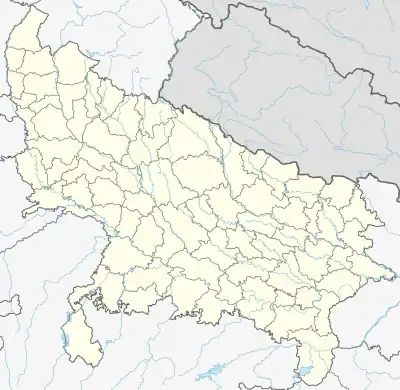Digha
Dīgha | |
|---|---|
Village | |
 Map showing Digha (#389) in Chhatoh CD block | |
 Digha Location in Uttar Pradesh, India | |
| Coordinates: 26°11′44″N 81°34′44″E / 26.195607°N 81.578838°E[1] | |
| Country India | |
| State | Uttar Pradesh |
| District | Raebareli |
| Area | |
| • Total | 4.635 km2 (1.790 sq mi) |
| Population (2011)[2] | |
| • Total | 1,536 |
| • Density | 330/km2 (860/sq mi) |
| Languages | |
| • Official | Hindi |
| Time zone | UTC+5:30 (IST) |
| Vehicle registration | UP-35 |
Digha is a village in Chhatoh block of Rae Bareli district, Uttar Pradesh, India.[2] It is located 7 km from Jais, the nearest town.[3] As of 2011, Digha has a population of 1,536 people, in 288 households.[2] It has one primary school and no healthcare facilities.[2] It belongs to the nyaya panchayat of Paraiya Namaksar.[4]
The 1951 census recorded Digha as comprising 5 hamlets, with a total population of 480 people (227 male and 253 female), in 46 households and 41 physical houses.[5] The area of the village was given as 920 acres.[5] 11 residents were literate, all male.[5] The village was listed as belonging to the pargana of Rokha and the thana of Nasirabad.[5]
The 1961 census recorded Digha as comprising 5 hamlets, with a total population of 574 people (277 male and 297 female), in 142 households and 121 physical houses.[6] The area of the village was given as 920 acres.[6]
The 1981 census recorded Digha (as "Deegha") as having a population of 698 people, in 135 households, and having an area of 356.13 hectares.[3] The main staple foods were listed as wheat and rice.[3]
The 1991 census recorded Digha as having a total population of 874 people (472 male and 402 female), in 189 households and 189 physical houses.[4] The area of the village was listed as 351 hectares.[4] Members of the 0-6 age group numbered 138, or 15.8% of the total; this group was 50% male (69) and 50% female (69).[4] Members of scheduled castes made up 43.1% of the village's population, while no members of scheduled tribes were recorded.[4] The literacy rate of the village was 13% (100 men and 11 women).[4] 324 people were classified as main workers (274 men and 50 women), while 0 people were classified as marginal workers; the remaining 550 residents were non-workers.[4] The breakdown of main workers by employment category was as follows: 294 cultivators (i.e. people who owned or leased their own land); 25 agricultural labourers (i.e. people who worked someone else's land in return for payment); 0 workers in livestock, forestry, fishing, hunting, plantations, orchards, etc.; 0 in mining and quarrying; 0 household industry workers; 2 workers employed in other manufacturing, processing, service, and repair roles; 0 construction workers; 0 employed in trade and commerce; 0 employed in transport, storage, and communications; and 3 in other services.[4]
References
- ↑ ""Geonames Search"". Do a radial search using these coordinates here.
- 1 2 3 4 5 "Census of India 2011: Uttar Pradesh District Census Handbook - Rae Bareli, Part A (Village and Town Directory)" (PDF). Census 2011 India. pp. 410–26. Retrieved 31 August 2021.
- 1 2 3 Census 1981 Uttar Pradesh: District Census Handbook Part XIII-A: Village & Town Directory, District Rae Bareli (PDF). 1982. pp. 200–1. Retrieved 31 August 2021.
- 1 2 3 4 5 6 7 8 Census 1991 Series-25 Uttar Pradesh Part-XII B Village & Townwise Primary Census Abstract District Census Handbook District Raebareli (PDF). 1992. pp. xxiv–xxviii, 252–3. Retrieved 14 October 2021.
- 1 2 3 4 Census of India, 1951: District Census Handbook Uttar Pradesh (42 - Rae Bareli District) (PDF). Allahabad. 1955. pp. 160–1. Retrieved 14 October 2021.
{{cite book}}: CS1 maint: location missing publisher (link) - 1 2 Census 1961: District Census Handbook, Uttar Pradesh (39 - Raebareli District) (PDF). Lucknow. 1965. pp. c-ci of section "Salon Tahsil". Retrieved 31 August 2021.
{{cite book}}: CS1 maint: location missing publisher (link)